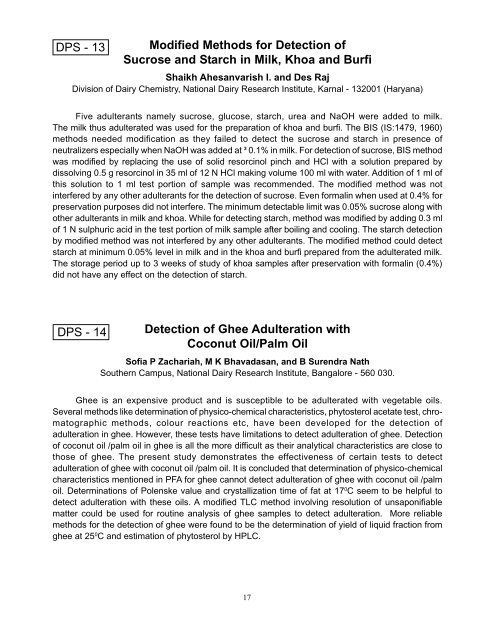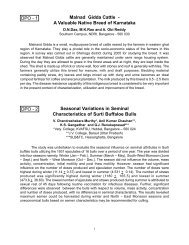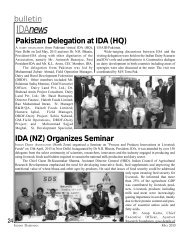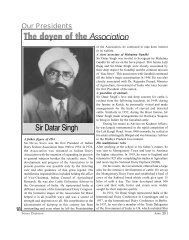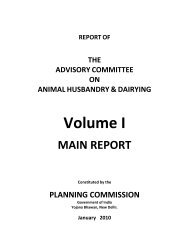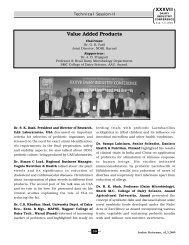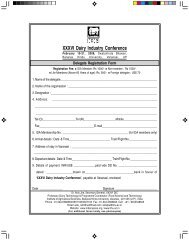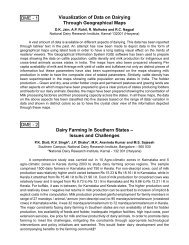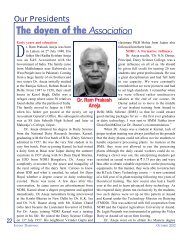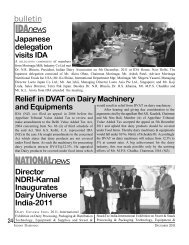Prevalence of Antibiotic Resistance in Dairy Strains of Streptococcus ...
Prevalence of Antibiotic Resistance in Dairy Strains of Streptococcus ...
Prevalence of Antibiotic Resistance in Dairy Strains of Streptococcus ...
Create successful ePaper yourself
Turn your PDF publications into a flip-book with our unique Google optimized e-Paper software.
DPS - 13Modified Methods for Detection <strong>of</strong>Sucrose and Starch <strong>in</strong> Milk, Khoa and BurfiShaikh Ahesanvarish I. and Des RajDivision <strong>of</strong> <strong>Dairy</strong> Chemistry, National <strong>Dairy</strong> Research Institute, Karnal - 132001 (Haryana)Five adulterants namely sucrose, glucose, starch, urea and NaOH were added to milk.The milk thus adulterated was used for the preparation <strong>of</strong> khoa and burfi. The BIS (IS:1479, 1960)methods needed modification as they failed to detect the sucrose and starch <strong>in</strong> presence <strong>of</strong>neutralizers especially when NaOH was added at ³ 0.1% <strong>in</strong> milk. For detection <strong>of</strong> sucrose, BIS methodwas modified by replac<strong>in</strong>g the use <strong>of</strong> solid resorc<strong>in</strong>ol p<strong>in</strong>ch and HCl with a solution prepared bydissolv<strong>in</strong>g 0.5 g resorc<strong>in</strong>ol <strong>in</strong> 35 ml <strong>of</strong> 12 N HCl mak<strong>in</strong>g volume 100 ml with water. Addition <strong>of</strong> 1 ml <strong>of</strong>this solution to 1 ml test portion <strong>of</strong> sample was recommended. The modified method was not<strong>in</strong>terfered by any other adulterants for the detection <strong>of</strong> sucrose. Even formal<strong>in</strong> when used at 0.4% forpreservation purposes did not <strong>in</strong>terfere. The m<strong>in</strong>imum detectable limit was 0.05% sucrose along withother adulterants <strong>in</strong> milk and khoa. While for detect<strong>in</strong>g starch, method was modified by add<strong>in</strong>g 0.3 ml<strong>of</strong> 1 N sulphuric acid <strong>in</strong> the test portion <strong>of</strong> milk sample after boil<strong>in</strong>g and cool<strong>in</strong>g. The starch detectionby modified method was not <strong>in</strong>terfered by any other adulterants. The modified method could detectstarch at m<strong>in</strong>imum 0.05% level <strong>in</strong> milk and <strong>in</strong> the khoa and burfi prepared from the adulterated milk.The storage period up to 3 weeks <strong>of</strong> study <strong>of</strong> khoa samples after preservation with formal<strong>in</strong> (0.4%)did not have any effect on the detection <strong>of</strong> starch.DPS - 14Detection <strong>of</strong> Ghee Adulteration withCoconut Oil/Palm OilS<strong>of</strong>ia P Zachariah, M K Bhavadasan, and B Surendra NathSouthern Campus, National <strong>Dairy</strong> Research Institute, Bangalore - 560 030.Ghee is an expensive product and is susceptible to be adulterated with vegetable oils.Several methods like determ<strong>in</strong>ation <strong>of</strong> physico-chemical characteristics, phytosterol acetate test, chromatographicmethods, colour reactions etc, have been developed for the detection <strong>of</strong>adulteration <strong>in</strong> ghee. However, these tests have limitations to detect adulteration <strong>of</strong> ghee. Detection<strong>of</strong> coconut oil /palm oil <strong>in</strong> ghee is all the more difficult as their analytical characteristics are close tothose <strong>of</strong> ghee. The present study demonstrates the effectiveness <strong>of</strong> certa<strong>in</strong> tests to detectadulteration <strong>of</strong> ghee with coconut oil /palm oil. It is concluded that determ<strong>in</strong>ation <strong>of</strong> physico-chemicalcharacteristics mentioned <strong>in</strong> PFA for ghee cannot detect adulteration <strong>of</strong> ghee with coconut oil /palmoil. Determ<strong>in</strong>ations <strong>of</strong> Polenske value and crystallization time <strong>of</strong> fat at 17 0 C seem to be helpful todetect adulteration with these oils. A modified TLC method <strong>in</strong>volv<strong>in</strong>g resolution <strong>of</strong> unsaponifiablematter could be used for rout<strong>in</strong>e analysis <strong>of</strong> ghee samples to detect adulteration. More reliablemethods for the detection <strong>of</strong> ghee were found to be the determ<strong>in</strong>ation <strong>of</strong> yield <strong>of</strong> liquid fraction fromghee at 25 0 C and estimation <strong>of</strong> phytosterol by HPLC.17


